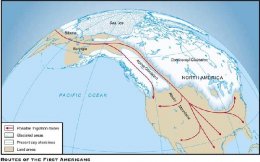Post by ItsJoanNotJoAnnPost by Hiram FreebornPost by ItsJoanNotJoAnnPost by Cindy HamiltonI usually call it "Native American Subjugation Day".
Don't forget those native Americans stole land from someone
else when they skipped across that land bridge a few zillion
years ago.
Dineh say...who us???
Until you learn to quote correctly, I'll not answer you.
Where is the misquote?
I trimmed to relevance, as is preferred protocol here.
My reply was not on the matter of stuffing turkeys.
So then?
_________________________________________________________________________________
Post by ItsJoanNotJoAnnPost by Hiram FreebornPost by ItsJoanNotJoAnnMy wife had ordered a fresh turkey and I picked it up today. I was a
little disappointed that we ended up with a bigger bird that I had
wanted. It's hard to get then 12 lb or less.
Could you have requested the turkey be split down the middle
and frozen for a later date??
How do you stuff a split turkey? It's just a vessel for stuffing.
I don't know, I've never stuffed a turkey and know no one
who has.
Post by ItsJoanNotJoAnnPost by Hiram FreebornTomorrow is a federal holiday here, Columbus Day. But if
you are overly sensitive it is "Indigenous People Day."
I usually call it "Native American Subjugation Day".
Don't forget those native Americans stole land from someone
else when they skipped across that land bridge a few zillion
years ago.
__________________________________________________________________________________
I believe my citation is authoritative and also accurate:
https://navajopeople.org/blog/ancient-navajo-and-native-americas-migrations/
Loading Image...
That a land bridge between Asia and North America existed during the
last ice age is strongly supported by geological evidence. Ocean water
locked up in glacial ice lowered sea levels to the point where a
corridor up to 1600km or more wide existed between Siberia and Alaska.
“Long before Euro-Americans entered the Great Basin, substantial numbers
of people lived within the present boundaries of Utah. Archaeological
reconstructions suggest human habitation stretching back some 12,000
years. The earliest known inhabitants were members of what has been
termed the Desert Archaic Culture–nomadic hunter-gatherers with
developed basketry, flaked-stem stone tools, and implements of wood and
bone. They inhabited the region between 10,000 B.C. and A.D. 400.
These peoples moved in extended family units, hunting small game and
gathering the periodically abundant seeds and roots in a slightly more
cool and moist Great Basin environment.
About A.D. 400, the Fremont Culture began to emerge in northern and
eastern Utah out of this Desert tradition. The Fremont peoples retained
many Desert hunting-gathering characteristics yet also incorporated a
maize-bean-squash horticultural component by A.D. 800-900. They lived in
masonry structures and made sophisticated basketry, pottery, and clay
figurines for ceremonial purposes. Intrusive Numic peoples displaced or
absorbed the Fremont sometime after A.D. 1000.
Beginning in A.D. 400, the Anasazi, with their Basketmaker Pueblo
Culture traditions, moved into southeastern Utah from south of the
Colorado River. Like the Fremont to the north the Anasazi (a Navajo word
meaning “the ancient ones”) were relatively sedentary peoples who had
developed a maize-bean-squash-based agriculture.
The Anasazi built rectangular masonry dwellings and large apartment
complexes that were tucked into cliff faces or situated on valley floors
like the structures at Grand Gulch and Hovenweep National Monument. They
constructed pithouse granaries, made coiled and twined basketry, clay
figurines, and a fine gray-black pottery. The Anasazi prospered until
A.D. 1200-1400 when climactic changes, crop failures, and the intrusion
of Numic hunter-gatherers forced a southward migration and reintegration
with the Pueblo peoples of Arizona and New Mexico.”
Archaeologists believe the indigenous peoples that eventually populated
the Americas occurred in three separate migrations.The largest of these
groups is referred to as the Amerind (Paleo-Indians). The Amerind, which
includes most Native Americans south of the Canadian border, commenced
around 11,500 B.C..A second migration called the Na-Dene occurred
between 10,000 B.C. and 8, 000 B.C.. Even though at this point the
Bering Sea separated Siberia and Alaska, it was only three miles wide in
some places.
The Athapascan speaking populations of Canada and the United States
belong to this group of migrants. The Apache and Navajo in the
southwestern United States are from the Athapascan migrants.
The third migration around 3,000 B.C. included the Aleuts and Eskimos of
Alaska, Canada, and the Aleutian Islands (Taylor).
According to modern belief The Navajos are descended from that great
race which produced Genghis Khan and conquered in his lifetime half the
world. While the victorious Mongols were driving relentlessly west and
south, making kings and emperors their vassals, some small fragments of
their clans were crossing Bering Sea, probably on the ice, and gradually
overrunning North America.
There are, many significant facts which, to the student of literature at
least, prove an Asiatic origin.The Venetian traveler, Marco Polo, who
visited the Court of Kublai Khan in 1275, gives some very interesting
accounts of the Mongols,At a later date the French Jesuit, M. Hue,
describes the wild tribes of the Grasslands. We have thus a picture of
the social life of the Mongols with which to make comparisons.
Both authors agree that among the primitive Mongols the women attended
to all the trading.They bought and sold and provided every necessity for
their husbands and families: ‘The time of the men,’ as Marco Polo says,
‘being entirely devoted to hunting, hawking, and matters that relate to
military life.’
The same is true among the Navajos to-day, as far as the women are
concerned.
“Wherever they went — until the white people subdued them — the Dineh’
like the Mongols, were raiders and spoilers. The mystery of the vanished
Cliff-Dwellers is a mystery no longer when we know the nature of the
warriors who came among them. The Zuñis told Cushing that twenty-two
different tribes had been wiped out by the Enemy People, as they called
them; and the walled-up doors of proud Pueblo Bonito testify mutely to
the fears of its inhabitants.” (Dane Coolidge 1930)
Happy Dine' Day then to all!
Or most...
Or some...
Or...